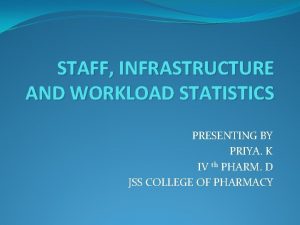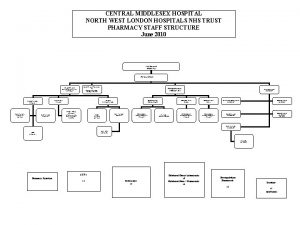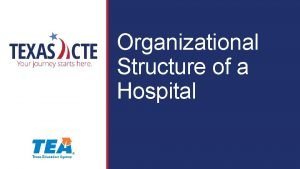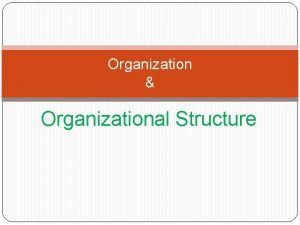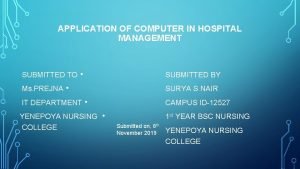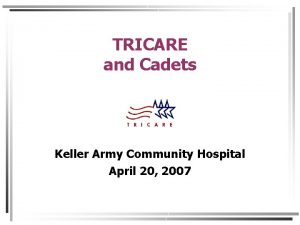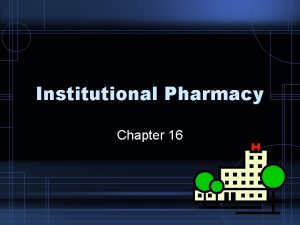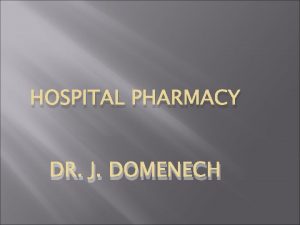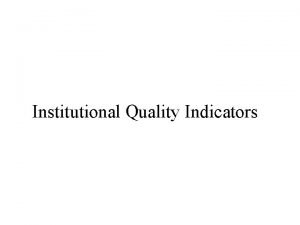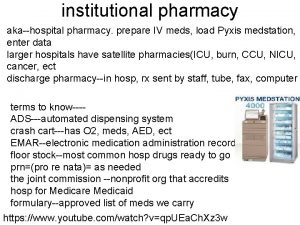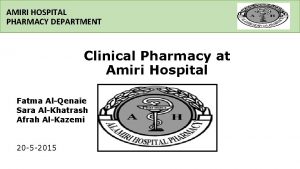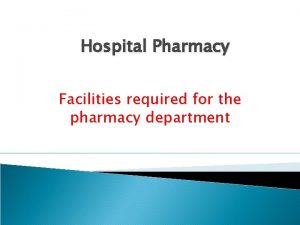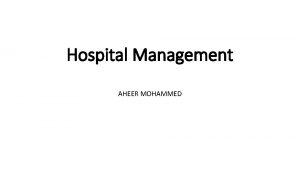Institutional Pharmacy Chapter 16 Hospital Pharmacy In hospital
















- Slides: 16

Institutional Pharmacy Chapter 16

Hospital Pharmacy • In hospital pharmacy technicians work as part of a team. • In hospitals, rooms are divided into groups called nursing units or patient care units. • Patents with similar problems are usually located together. • Read: Health care team page 317

Hospital Pharmacy Areas • Centralized Pharmacy systems – all pharmacy activities are conducted from one area within the hospital—called the inpatient pharmacy. • Decentralized Pharmacy systems – there are several satellite pharmacy areas located throughout the hospital, each serving a portion of the patient care areas.

Communication • There are several ways the pharmacy communicated with other areas of the hospital: – Fax – Telephone – Computer – In person – Pneumatic Tubes (shuttles items through a tube using compressed air) – Dumbwaiter (a small elevator to carry items between floors, but not people)

Computer Systems • Hospital computer systems can integrate and store patient information such as medical records, lab data and billing records. • Hospital computer systems differ from community pharmacy systems in some of the information they track-such as lab results and medical records.

Organization of Medication • Since hospitals cannot stock every medication available, most have a hospital formulary. • A formulary is a subset of medications the hospital keeps on its shelves from which a doctor can order.

Organization of Medication • Medication is usually organized alphabetically by generic name in hospital pharmacy. • In community pharmacy, medications are usually organized alphabetically by brand. • Read pages 322 & 323: hospital formulary, therapeutic interchanges, P&T committees, organization of medication

Unit Dose System • Medications are commonly provided to the nursing unit in medication cart containing 24 hours dosages for specific patients. (see illustrations page 325) • Medications in the cart are packaged in unit dose containers—holding a single dose of the medication.

Medication Orders & Order Processing • In hospitals, all drugs ordered for a patient are written on a medication order form or are electronically transmitted to the pharmacy. (see pages 326 -327) • Pharmacists must verify orders in the computer system and may check medications before they are sent to the floor. • In California, we now have “tech-check” where specifically trained techs can perform this last step provided the hospital has tech check protocols & training in place. (New this year)

Medication Orders & Order Processing • Standing Order – a standard medication that a patient is to receive at scheduled intervals. (eg: 1 tab q 8) • PRN Order – an order for medications to be administered only on an as needed basis. (eg: prn pain) • STAT Order – an order for medication to be administered immediately.

Inventory Control • A primary area of concern for inventory control is narcotics or controlled substances. – These require an exact record of the location & the exact count of every item. • Code Carts – a locked cart of emergency medication & equipment designed for emergency use only. ( see page 330) • Floor Stock – stock that is stored at the nursing station, does not require specific patient labeling.

General Hospital Issues • All departments within the hospital are required to maintain a policy & procedures manual by regulating agencies. • Joint Commission on Accreditation of Healthcare Organizations (JCAHO): – Surveys & accredits health care organizations – Organizations undergo survey every 3 years

Safety • During safety training, employees will learn universal precautions & how to handle hazardous spills. (Page 333) • Needles and other “sharps” should always be disposed in designated “sharps” containers.

Long Term Care • Long Term care facilities provide care for people unable to care for themselves. • Because of limited resources, most long term care facility contract out pharmacy services.

Long Term Care • Pharmacists provide dispensing serves and clinical services. • Distributive pharmacists – make sure the long term care patients receive the correct medication ordered. • Consultant pharmacists – develop & maintain an individual pharmacy plan for each patient.

Chapter 16 • Read all sections of Chapter 16 • Review Key Concepts • Take Self-Test
 Pharmacy definition
Pharmacy definition Infrastructure of hospital pharmacy
Infrastructure of hospital pharmacy Objectives of hospital pharmacy
Objectives of hospital pharmacy North middlesex hospital pharmacy
North middlesex hospital pharmacy Texas education agency organizational chart
Texas education agency organizational chart Organization structure of hospital pharmacy
Organization structure of hospital pharmacy Parklands hospital pharmacy
Parklands hospital pharmacy Individual prescription order system
Individual prescription order system Brampton civic hospital pharmacy
Brampton civic hospital pharmacy St george private hospital pharmacy
St george private hospital pharmacy Emergency drugs in crash cart
Emergency drugs in crash cart Clinical pharmacy meaning
Clinical pharmacy meaning Application of computer in the field of hospital
Application of computer in the field of hospital Mologne health clinic
Mologne health clinic Organizational structure of hospital pharmacy
Organizational structure of hospital pharmacy Hospital pharmacy quiz
Hospital pharmacy quiz Non charge floor stock drugs list
Non charge floor stock drugs list

